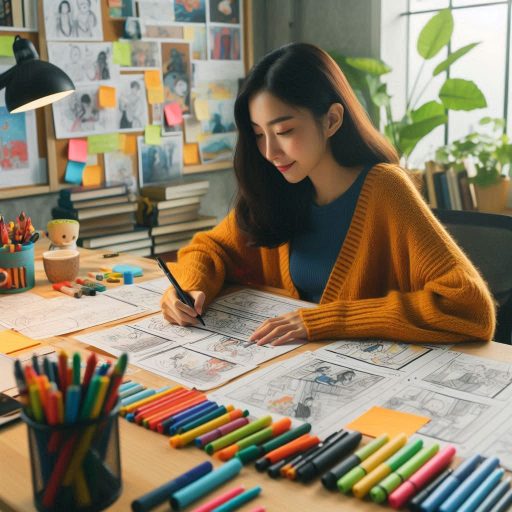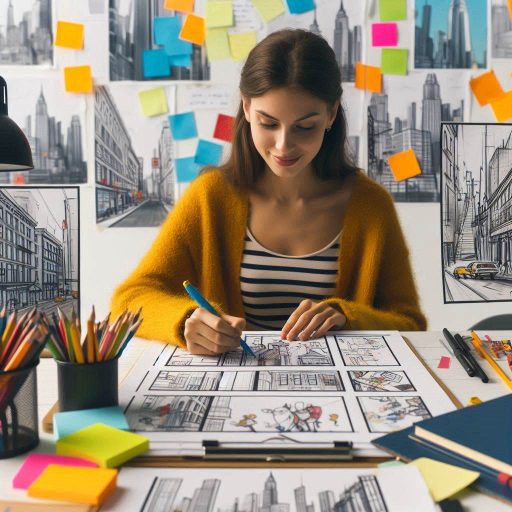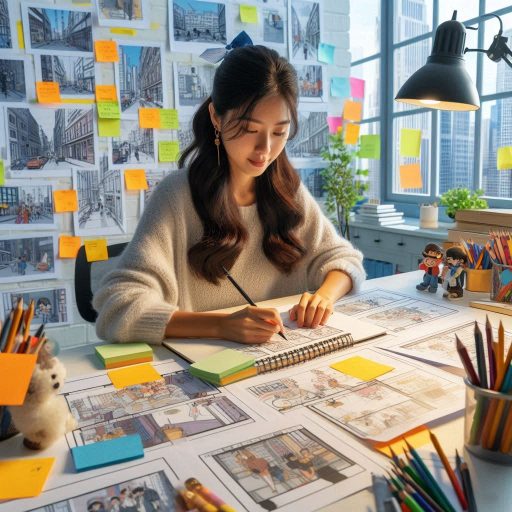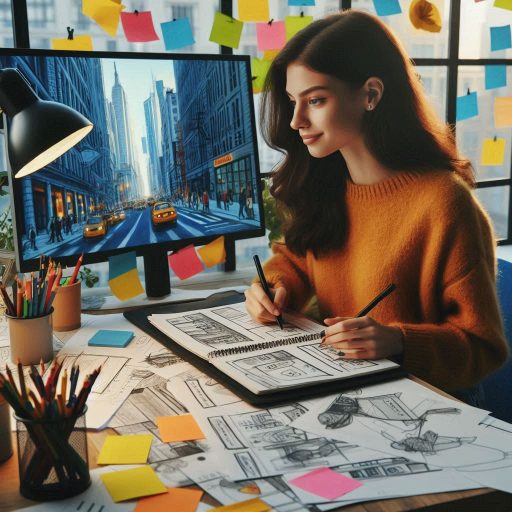Introduction
A storyboard is a visual representation that outlines scenes in animation.
It consists of a series of illustrations that depict key moments and actions.
Storyboards serve as a blueprint, guiding the entire animation process from start to finish.
Storyboarding plays a vital role in animation by establishing the narrative structure.
It allows creators to visualize scenes before production begins, ensuring clarity in storytelling.
By sketching out sequences, animators can identify pacing and timing, which enhances the overall flow of the animation.
Storyboarding helps teams collaborate effectively.
Directors, animators, and writers can discuss ideas and make necessary adjustments early in the process.
This collaborative approach reduces misunderstandings and saves time during production.
Visualizing the project through storyboarding allows creators to experiment with different angles and compositions.
Artists can explore character movements and interactions, leading to more dynamic scenes.
Moreover, storyboarding helps in identifying potential issues, allowing teams to address them before animation starts.
Ultimately, storyboarding is essential for successful animation projects.
It provides a clear roadmap, facilitating smoother communication and enhancing the creative process.
By investing time in storyboarding, teams can create engaging and visually compelling animations that resonate with audiences.
Importance of Storyboarding
How Storyboarding Helps in Organizing the Flow of the Story
Storyboarding plays a crucial role in organizing the flow of an animation story.
It allows artists to break down the script into manageable scenes.
Each storyboard panel represents a key moment, making the narrative easier to visualize.
This process helps identify pacing, ensuring the story unfolds logically.
By arranging scenes visually, creators can spot inconsistencies or gaps in the plot.
Storyboards also allow for exploring different narrative paths before committing to final animation.
This flexibility supports a more refined storytelling approach, enhancing the overall narrative structure.
Ultimately, storyboarding becomes the blueprint that guides the entire animation project.
How It Helps in Making Crucial Decisions About Camera Angles, Shot Compositions, and Pacing
Storyboarding aids in making vital decisions about camera angles and shot compositions.
Artists can experiment with various perspectives before finalizing their choices.
This experimentation allows for a deeper exploration of how each shot impacts storytelling.
The storyboard serves as a visual guide for camera movements, ensuring smooth transitions between scenes.
Storyboarding also establishes the rhythm and pacing of the animation.
By deciding the timing for each shot, creators can build tension or emphasize moments.
Clear shot compositions enhance the viewer’s understanding of the story, making it more engaging.
Storyboards thus facilitate informed decisions, optimizing the visual storytelling experience.
How Storyboarding Helps in Communicating the Vision of the Project to the Entire Team
Storyboarding effectively communicates the project’s vision to the entire team.
It serves as a shared reference point for directors, animators, and producers.
This visual guide helps align everyone‘s understanding of the story‘s direction.
Artists can use storyboards to illustrate character actions and emotional beats clearly.
This clarity minimizes miscommunication and streamlines the production process.
During meetings, storyboards facilitate discussions about artistic choices and project goals.
They provide a tangible representation of the story, fostering collaboration and creativity.
With storyboards, team members can envision the final product, ensuring everyone is on the same page.
Understanding the storyboarding process is essential in animation.
Storyboarding organizes the narrative flow, helping creators visualize their stories clearly.
It aids in making critical decisions about camera angles, shot compositions, and pacing, ensuring a cohesive viewing experience.
Moreover, it enhances communication among team members, aligning everyone with the project’s vision.
By prioritizing storyboarding, animators set the foundation for a successful animation project, ultimately leading to captivating storytelling.
Read: Top Skills Needed for Art Educators and Instructors
Elements of a Storyboard
Break Down the Components of a Storyboard
Understanding the components of a storyboard is crucial in animation.
A storyboard consists of panels that represent individual shots.
Each panel captures a specific moment in the narrative.
Shot descriptions accompany each panel, detailing the action, setting, and mood.
These descriptions help convey the intended visual elements clearly.
Dialogue appears below or within the panels, providing context for the characters.
This combination of visuals and text guides the animation process effectively.
The storyboard acts as a blueprint for animators and directors alike.
By breaking down the story into manageable parts, artists can visualize the entire narrative flow.
Discussing the Use of Arrows and Notes
Arrows and notes play a vital role in storyboarding.
They indicate movement and actions within each panel.
Arrows help illustrate how characters or objects move, enhancing the visual narrative.
This guidance allows animators to understand the intended dynamics of each shot.
Notes can provide additional context or specific instructions for animators.
For example, notes may clarify the mood of a scene or suggest camera angles.
This extra information ensures that everyone involved understands the creative vision.
Clear visual cues prevent misinterpretations and maintain the integrity of the story.
Together, arrows and notes transform static images into a dynamic visual plan.
Importance of Maintaining Consistency and Clarity
Maintaining consistency and clarity in a storyboard is essential for effective communication.
Each panel should reflect the same artistic style to ensure a cohesive look.
Inconsistent styles can confuse animators and disrupt the overall flow of the project.
Clarity is equally important; each shot must be easily understandable.
Viewers should grasp the story’s progression without confusion.
Clear labeling of panels, including scene numbers, helps keep everything organized.
This organization is crucial during the animation process, as it streamlines production.
Regular feedback and revisions also contribute to consistency and clarity.
Artists should collaborate closely to refine the storyboard, ensuring everyone is on the same page.
Understanding the storyboarding process in animation is vital for success.
Breaking down components like panels, shot descriptions, and dialogue helps create a structured narrative.
Arrows and notes enhance the storyboard by indicating movement and actions.
Maintaining consistency and clarity ensures that the artistic vision remains intact.
By following these guidelines, storyboard artists can effectively communicate their ideas.
This process lays the groundwork for successful animation, guiding animators throughout production.
Ultimately, a well-constructed storyboard serves as a roadmap for bringing stories to life.
Through careful planning and collaboration, animators can transform ideas into captivating visual experiences.
Read: Collaborating with Other Creative Roles
The Storyboarding Process
Step-by-Step Process of Creating a Storyboard
Creating a storyboard begins with script analysis.
Artists read the script thoroughly to understand the story‘s themes and character motivations.
They identify key scenes and plot points essential for visual storytelling.
This analysis helps in breaking down the script into manageable segments.
Next, artists draft a rough outline of the storyboard.
They sketch initial thumbnails to visualize each scene‘s composition and action.
These sketches do not need to be detailed; they only capture the essential elements.
Artists focus on framing, camera angles, and character positioning during this stage.
Once the thumbnails are ready, artists develop a more refined storyboard.
They create detailed sketches that include character expressions and background elements.
Artists also add dialogue and scene descriptions to provide context.
This step is crucial for conveying the narrative effectively.
After creating the detailed storyboard, artists present it for feedback.
Directors and writers review the storyboard, offering suggestions and revisions.
This collaborative process ensures everyone‘s vision aligns and meets project goals.
Artists revise the storyboard based on this feedback, enhancing clarity and visual impact.
Finally, artists finalize the storyboard for production.
They polish the drawings and make any necessary adjustments.
The finalized storyboard serves as a blueprint for the animation team, guiding the entire production process.
Collaboration with Directors and Writers
Collaboration is essential in the storyboarding process.
Artists work closely with directors and writers to bring the story to life visually.
This teamwork begins with discussions about the script and creative vision.
Directors share their ideas, concepts, and desired tones for each scene.
They provide insights into character motivations and overall themes.
Writers contribute their knowledge of dialogue and character arcs, helping artists understand the story‘s nuances.
As artists create storyboards, they regularly share their work with directors and writers.
This communication allows for immediate feedback and adjustments.
Artists value directors’ insights, as they help ensure the storyboard aligns with the intended vision.
Collaboration extends beyond initial drafts.
Artists may need to revise storyboards multiple times, incorporating feedback to improve clarity.
This iterative process strengthens the final product, as it reflects the collective vision of the creative team.
Iterative Nature of Storyboarding
The storyboarding process is inherently iterative.
Artists expect multiple revisions before reaching the final product.
Each feedback round presents an opportunity for improvement and refinement.
Initially, artists may present rough sketches to get an overview of the story’s flow.
Directors and writers analyze these drafts, offering constructive criticism and suggestions.
Artists revise the sketches based on this feedback, enhancing clarity and storytelling elements.
After revising, artists create more detailed versions of the storyboard.
This stage includes refined character expressions, backgrounds, and camera angles.
Again, they present these revisions for additional feedback.
This back-and-forth dialogue continues until the team reaches a consensus.
The iterative process helps identify potential issues early.
It allows artists to refine pacing, emotional beats, and visual coherence.
This continuous improvement ultimately leads to a polished storyboard that effectively communicates the story.
In closing, understanding the storyboarding process in animation involves several key steps.
Artists analyze the script, collaborate with directors and writers, and embrace an iterative approach.
By following this structured process, artists create compelling storyboards that serve as the foundation for successful animation projects.
Read: Historic Costume Design Inspirations
Tools and Techniques for Storyboarding
Introducing Digital Tools Like Storyboard Pro and Adobe Animate for Creating Storyboards Digitally
The animation industry has embraced digital tools for creating storyboards.
Software like Storyboard Pro streamlines the storyboarding process significantly.
It offers various features like drawing, animatics, and audio integration.
Artists can create, edit, and rearrange panels quickly.
Storyboard Pro enhances collaboration between team members through easy sharing.
Adobe Animate is another powerful tool for animators.
It allows artists to design storyboards while integrating animation seamlessly.
With these digital tools, artists can experiment with timing and transitions.
The software‘s flexibility encourages creativity and efficiency.
Digital storyboarding simplifies the process of visualizing complex scenes.
Using these tools, artists can produce high-quality storyboards faster than traditional methods.
Discussing Traditional Techniques Like Hand-Drawn Storyboards and Flipbooks
Despite the rise of digital tools, traditional techniques remain relevant.
Hand-drawn storyboards offer a personal touch that many artists appreciate.
These storyboards allow for quick sketches and spontaneous creativity.
Artists can express their ideas without the constraints of software.
Flipbooks also serve as a classic storytelling technique.
They allow animators to visualize motion in a tangible format.
Creating flipbooks encourages artists to understand timing and flow better.
While digital tools are efficient, hand-drawn methods foster artistic skills.
Many artists still prefer traditional techniques for their simplicity and directness.
These methods can complement digital workflows, enhancing the overall creative process.
The Importance of Understanding Cinematography and Composition Principles in Creating Effective Storyboards
Understanding cinematography and composition principles is crucial for storyboard artists.
Strong composition enhances storytelling by guiding viewer attention.
Artists must learn how to frame shots effectively to create visual interest.
They should understand the rule of thirds and leading lines.
These principles help create dynamic and engaging visuals.
Knowledge of camera angles also plays a significant role.
Different angles evoke various emotions and responses from viewers.
For example, high angles can create a sense of vulnerability.
In contrast, low angles can convey power and dominance.
Also, understanding lighting helps artists depict mood and atmosphere.
Proper use of light and shadow can elevate a storyboard‘s impact.
Moreover, timing is essential in animation.
Artists must consider pacing and rhythm when creating storyboards.
Understanding how each shot flows into the next enhances the narrative structure.
Effective storyboarding anticipates the viewer’s experience, making it a vital part of animation.
Artists who grasp these principles can create compelling storyboards that resonate with audiences.
Mastering cinematography and composition allows storyboard artists to visualize their ideas clearly.
The storyboarding process in animation involves various techniques and tools.
Digital tools like Storyboard Pro and Adobe Animate enhance efficiency and creativity.
However, traditional methods like hand-drawn storyboards and flipbooks remain valuable.
Understanding cinematography and composition principles is essential for effective storyboarding.
By mastering these elements, artists can produce high-quality storyboards that effectively communicate their vision.
The fusion of digital and traditional techniques enriches the storyboarding process.
Ultimately, a well-crafted storyboard serves as the backbone of a successful animation project.
Read: Breaking Down Iconic Movie Costumes
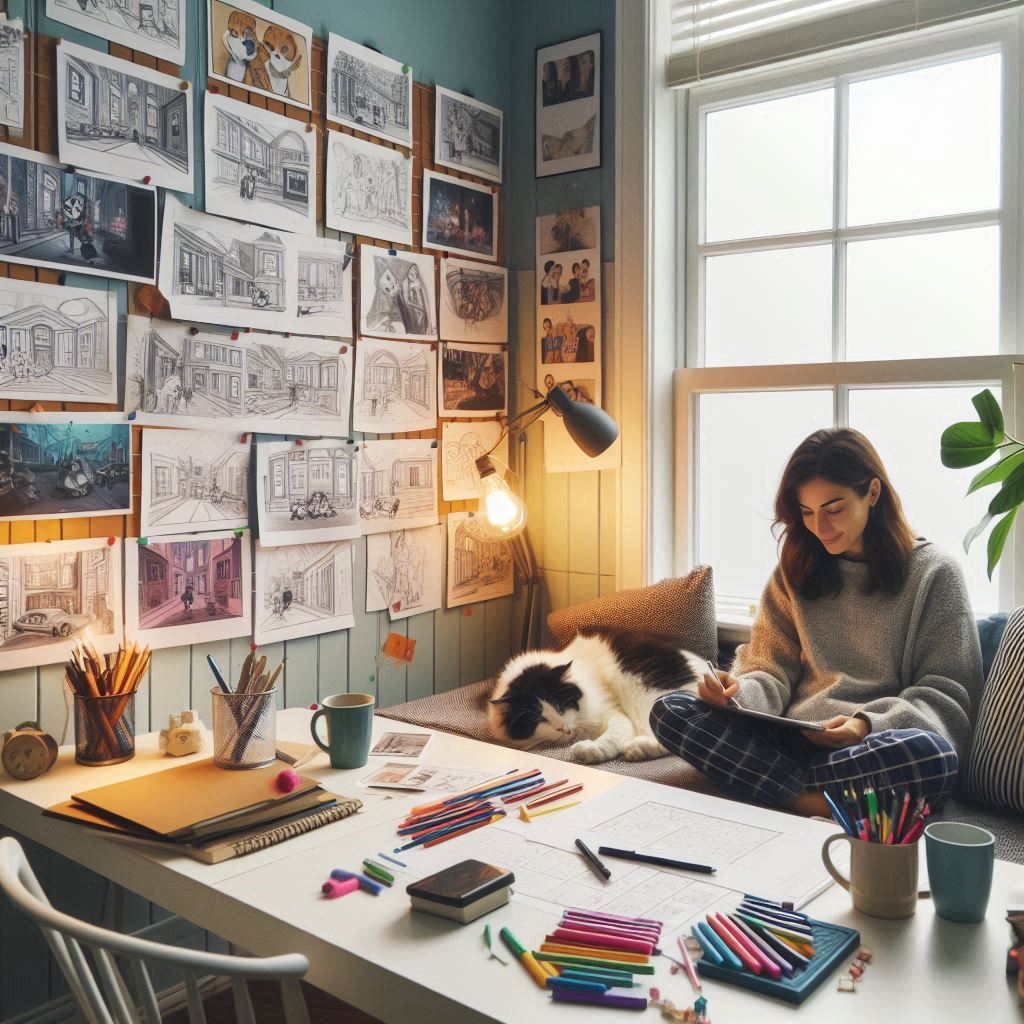
Storyboarding in Different Types of Animation
How Storyboarding Differs in 2D Animation, 3D Animation, and Stop Motion Animation
The storyboarding process varies significantly across different animation styles.
In 2D animation, artists create flat images to depict scenes.
These images are drawn frame by frame, emphasizing movement and timing.
Storyboards help visualize transitions, ensuring a cohesive flow.
In contrast, 3D animation involves creating three-dimensional models.
Storyboards in this context focus on camera angles and spatial relationships.
Artists use storyboards to outline key frames, defining movement within a 3D space.
This approach emphasizes depth, perspective, and lighting.
Stop motion animation requires a different approach altogether.
Artists use physical objects and puppets, capturing frame-by-frame movements.
Storyboards serve as guides to plan out each shot.
They help ensure that movements appear fluid and coherent.
Each animation style has unique requirements that influence the storyboarding process.
Understanding these differences is essential for effective visual storytelling.
How Different Animation Styles Require Unique Approaches to Storyboarding
Each animation style necessitates a tailored storyboarding approach.
In 2D animation, artists focus on character expressions and body language.
They illustrate scenes with clear movements to enhance the narrative.
For 3D animation, storyboards emphasize dynamic camera movements.
Artists consider how the camera interacts with 3D elements.
This requires detailed notes on angles, distances, and depth.
The storyboard must account for the software and tools used in production.
Stop motion animators need to think about physical movement and timing.
They often create storyboards that include notes on puppet manipulation.
These notes ensure that actions are executed consistently during filming.
Each approach demands an understanding of the medium‘s specific requirements.
Artists must adapt their techniques to suit the animation style.
Specific Challenges and Considerations for Storyboarding in Each Type of Animation
Storyboarding presents distinct challenges across different animation types.
In 2D animation, maintaining consistency in character design can be difficult.
Artists must ensure that characters look the same across all frames.
This requires a strong understanding of proportions and angles.
In 3D animation, managing complex camera movements poses challenges.
Artists need to consider how objects interact within a three-dimensional environment.
This requires attention to detail in spacing and timing.
Stop motion animation introduces unique challenges related to physicality.
Artists must ensure that puppets and props maintain their positions accurately.
Small shifts in setup can lead to noticeable discrepancies in movement.
Additionally, time constraints can pressure storyboard artists in all styles.
Tight deadlines require efficient planning and execution.
Artists must balance creativity with the need for timely delivery.
Understanding the storyboarding process in animation is crucial for successful projects.
Each style‘2D, 3D, and stop motion‘requires a unique approach.
Artists must navigate specific challenges and considerations to bring their visions to life.
By adapting their techniques to fit each medium, they enhance the storytelling experience.
Transform Your Career Today
Unlock a personalized career strategy that drives real results. Get tailored advice and a roadmap designed just for you.
Start NowCollaboration and Communication in Storyboarding
The Collaborative Nature of Storyboarding
Storyboarding is a highly collaborative process in animation.
It involves input from directors, animators, writers, and other team members.
Each participant brings unique perspectives and expertise to the project.
This collaboration fosters creativity and ensures that the final product aligns with the overall vision.
Directors provide guidance on the narrative and emotional tone.
They help storyboard artists understand the intended pacing and visual style.
Animators contribute their knowledge about movement and character design.
Their insights can greatly influence how scenes are framed and executed.
Writers play a crucial role in shaping the storyboard.
They clarify dialogue and key story points that need emphasis.
Collaborating closely, all team members can brainstorm ideas and make adjustments.
This teamwork allows for a more dynamic and engaging storyboard that serves the project‘s goals.
Clear Communication Through Storyboards
Clear communication is essential for successful storyboarding in animation.
Storyboards act as a visual roadmap, aligning everyone’s vision for the project.
They provide a frame-by-frame depiction of the narrative, helping team members visualize the final outcome.
When storyboard artists create detailed illustrations, they help clarify complex scenes.
This clarity minimizes misunderstandings between departments, streamlining the production process.
All team members can reference the storyboards to ensure they remain on the same page.
Incorporating annotations and notes within the storyboard enhances communication further.
Artists can explain character actions, camera angles, and scene transitions.
This additional information aids animators in understanding the artist’s intent.
As a result, everyone works toward a unified vision, reducing the likelihood of revisions later.
The Role of Storyboard Artists
Storyboard artists play a pivotal role in translating scripts into visual sequences.
They take the written narrative and transform it into a series of illustrations.
This process effectively conveys the story and highlights critical moments.
Artists begin by reading the script thoroughly.
They identify key scenes, emotions, and actions that need visual representation.
Once they understand the narrative flow, they sketch initial concepts to visualize the scenes.
These sketches serve as the foundation for the final storyboard.
As the storyboard develops, artists focus on pacing and composition.
They determine how long each scene should last and how to frame the action.
This attention to detail enhances storytelling by emphasizing crucial elements.
Storyboard artists also ensure that character expressions and movements align with the narrative.
They illustrate emotions and interactions, making the story more engaging.
Their work provides animators with clear guidelines for character animation and scene transitions.
In short, the storyboarding process in animation relies heavily on collaboration.
Input from directors, animators, and writers shapes the final storyboard.
Clear communication through visual aids aligns the entire team‘s vision for the project.
Storyboard artists expertly translate scripts into compelling visual sequences.
This collaborative effort results in a cohesive and engaging animated story that resonates with audiences.
By understanding and valuing each step, animation teams can produce high-quality content that captures their unique vision.
See Related Content: Exploring the Intersection of Art and Furniture Design
Conclusion
The storyboarding process is crucial in animation.
It serves as the visual blueprint for the entire project.
Artists create a series of sketches that outline key scenes and actions.
This helps to visualize the narrative and establish pacing before production begins.
Storyboards communicate ideas effectively to the entire team, ensuring everyone shares a common vision.
Good storyboarding helps identify potential issues early.
Artists can experiment with camera angles, character movements, and scene transitions.
This stage allows for easy revisions, saving time and resources in the long run.
Successful animated projects rely on well-thought-out storyboards to guide production.
Storyboarding fosters creativity.
It encourages artists to explore various styles and storytelling techniques.
Practicing storyboarding enhances your ability to convey emotions and actions visually.
By breaking down scenes into manageable parts, you can refine your storytelling skills.
I encourage readers to explore different storyboarding techniques, such as thumbnail sketches and digital tools.
Try analyzing existing animations to see how storyboards translate into final products.
Regular practice will improve your skills and confidence.
Embrace the storyboard process as an essential step in creating compelling animated stories.
Your journey as an animator will benefit greatly from mastering this foundational technique.
[E-Books for Sale]
The Big Book of 500 High-Paying Jobs in America: Unlock Your Earning Potential
$19.99 • 500 High-Paying Jobs • 330 pages
Explore 500 high-paying jobs in America and learn how to boost your career, earn more, and achieve success!
See All 500 High-Paying Jobs of this E-Book
1001 Professions Without a Degree: High-Paying American Jobs You Can Start Now
$19.99 • 1001 Professions Without a Degree • 174 pages
Discover 1001 high-paying jobs without a degree! Unlock career tips, skills, and success strategies for just $19.99!

